Consumer Behaviour B01CBEH209: Demographic Factors & Industry Impact
VerifiedAdded on 2023/06/07
|12
|2413
|228
Report
AI Summary
This report examines the impact of demographic factors such as age, income, and household type on consumer behavior, focusing on industries like cosmetics, pre-cooked foods, and tourism in Australia and New Zealand. It analyzes the influence of an aging population, baby boomers, Generation Y, and single-adult households on purchasing decisions and market trends. The report also considers cultural and socio-economic factors, including the increasing preference for online shopping and healthy pre-cooked meals, and the potential impact of climate change on these industries. The analysis highlights how businesses can leverage demographic insights to tailor their marketing strategies and product offerings to meet evolving consumer needs. Desklib provides access to a wide range of study resources, including solved assignments and past papers.
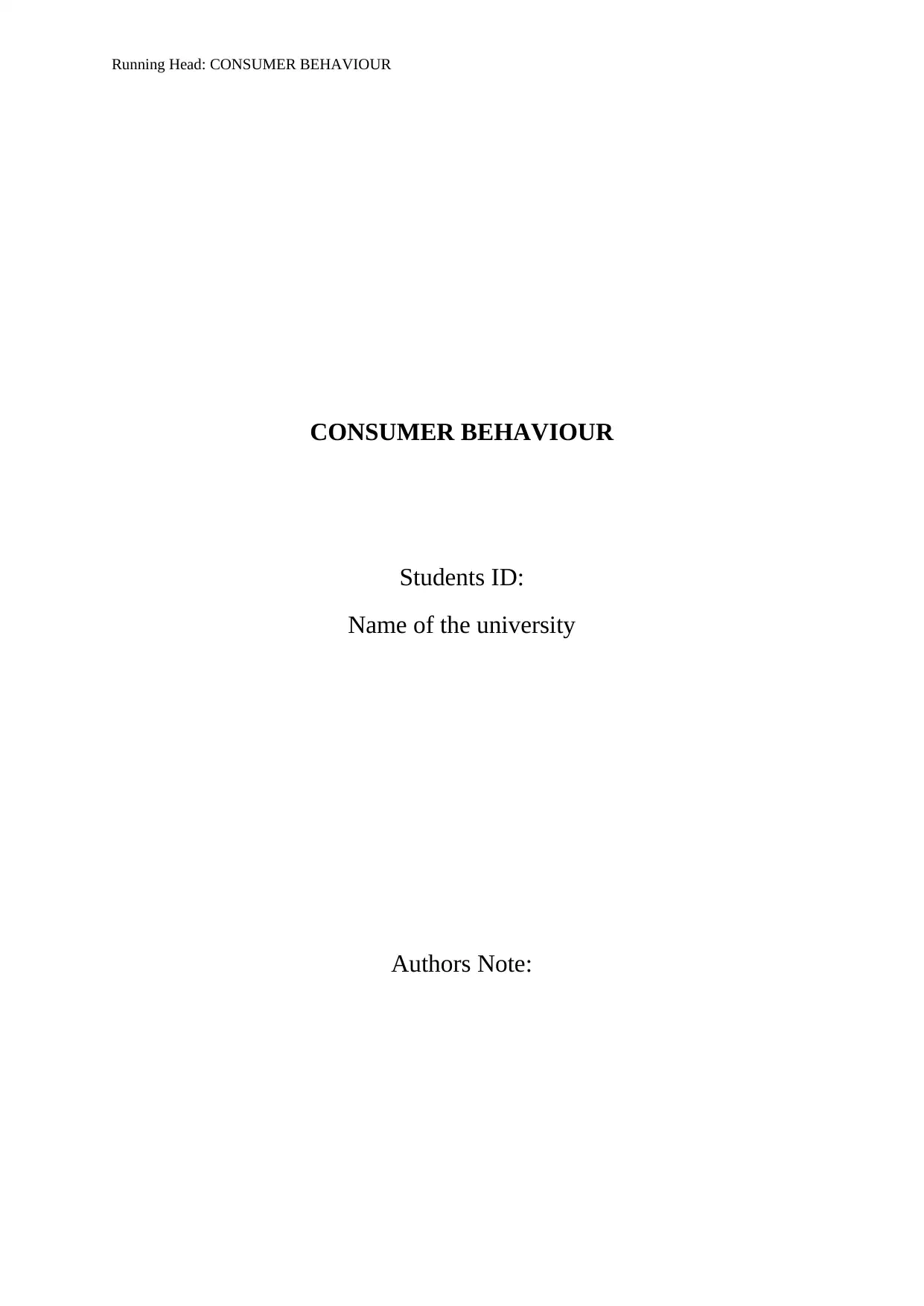
Running Head: CONSUMER BEHAVIOUR
CONSUMER BEHAVIOUR
Students ID:
Name of the university
Authors Note:
CONSUMER BEHAVIOUR
Students ID:
Name of the university
Authors Note:
Paraphrase This Document
Need a fresh take? Get an instant paraphrase of this document with our AI Paraphraser

2
CONSUMER BEHAVIOUR
Executive summary
The report focuses on consumer behaviour that is usually influenced by several
demographic factors that can vary from person to person based on age, sex, income and
education. A general approach to recognise the market and the consumer behaviour is by
understanding impact of demographic factors. In the event of the growing battle for grabbing
the maximum share in the market, only these manufacturers are destines to emerge as
successful those who will be able to understand the psychology and demand of the
consumers.
This is the reason for which consumer behaviour is necessary role to play in business
market. It can be easily noticed that there is a difference between buying decisions and
consumer attitude that comes from two different economy groups. In addition to this, the
study will focus on another major use of the demographic factors for supervising the change
in trends as well as culture for recognising new market opportunities.
CONSUMER BEHAVIOUR
Executive summary
The report focuses on consumer behaviour that is usually influenced by several
demographic factors that can vary from person to person based on age, sex, income and
education. A general approach to recognise the market and the consumer behaviour is by
understanding impact of demographic factors. In the event of the growing battle for grabbing
the maximum share in the market, only these manufacturers are destines to emerge as
successful those who will be able to understand the psychology and demand of the
consumers.
This is the reason for which consumer behaviour is necessary role to play in business
market. It can be easily noticed that there is a difference between buying decisions and
consumer attitude that comes from two different economy groups. In addition to this, the
study will focus on another major use of the demographic factors for supervising the change
in trends as well as culture for recognising new market opportunities.
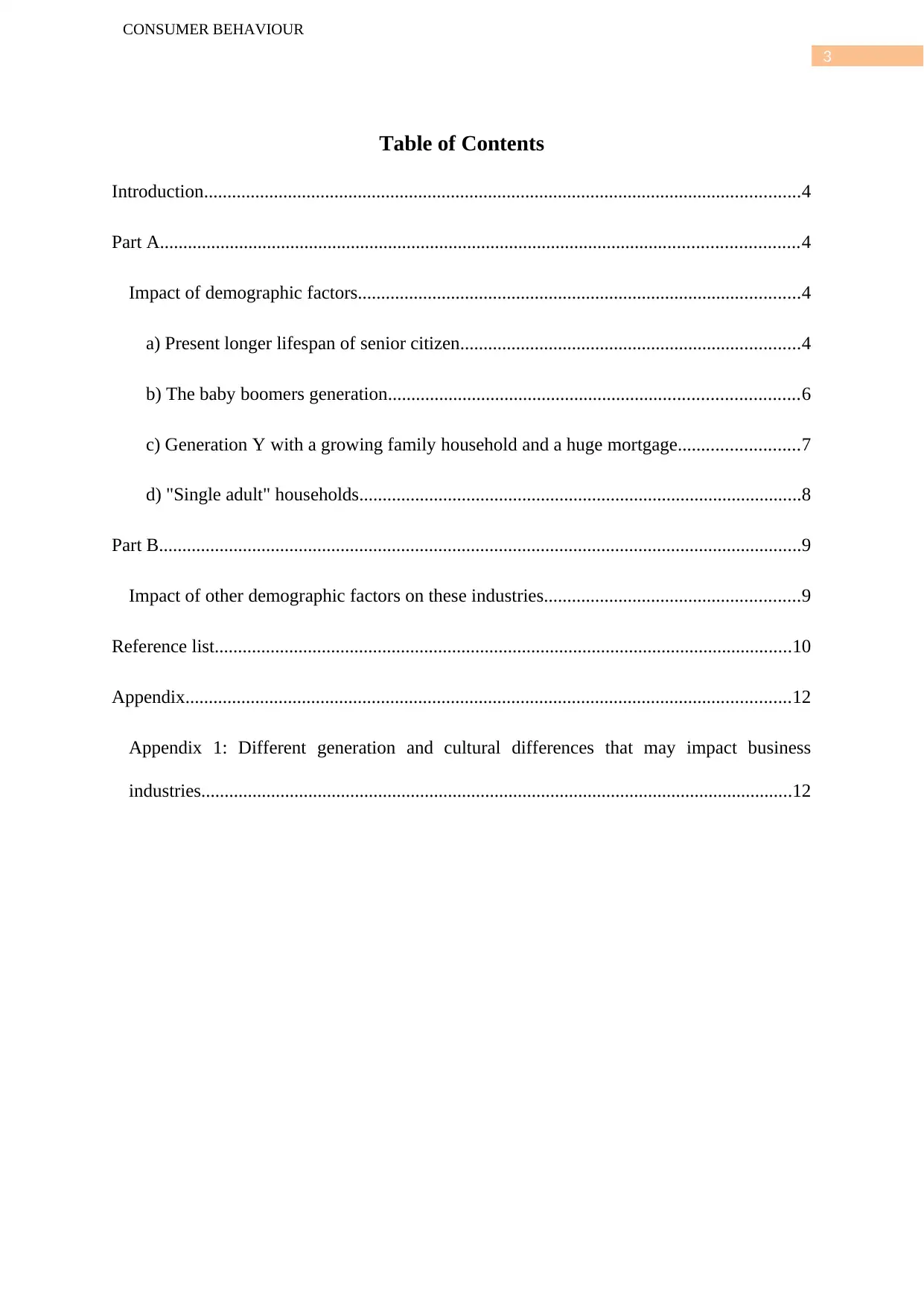
3
CONSUMER BEHAVIOUR
Table of Contents
Introduction................................................................................................................................4
Part A.........................................................................................................................................4
Impact of demographic factors...............................................................................................4
a) Present longer lifespan of senior citizen.........................................................................4
b) The baby boomers generation........................................................................................6
c) Generation Y with a growing family household and a huge mortgage..........................7
d) "Single adult" households...............................................................................................8
Part B..........................................................................................................................................9
Impact of other demographic factors on these industries.......................................................9
Reference list............................................................................................................................10
Appendix..................................................................................................................................12
Appendix 1: Different generation and cultural differences that may impact business
industries...............................................................................................................................12
CONSUMER BEHAVIOUR
Table of Contents
Introduction................................................................................................................................4
Part A.........................................................................................................................................4
Impact of demographic factors...............................................................................................4
a) Present longer lifespan of senior citizen.........................................................................4
b) The baby boomers generation........................................................................................6
c) Generation Y with a growing family household and a huge mortgage..........................7
d) "Single adult" households...............................................................................................8
Part B..........................................................................................................................................9
Impact of other demographic factors on these industries.......................................................9
Reference list............................................................................................................................10
Appendix..................................................................................................................................12
Appendix 1: Different generation and cultural differences that may impact business
industries...............................................................................................................................12
⊘ This is a preview!⊘
Do you want full access?
Subscribe today to unlock all pages.

Trusted by 1+ million students worldwide
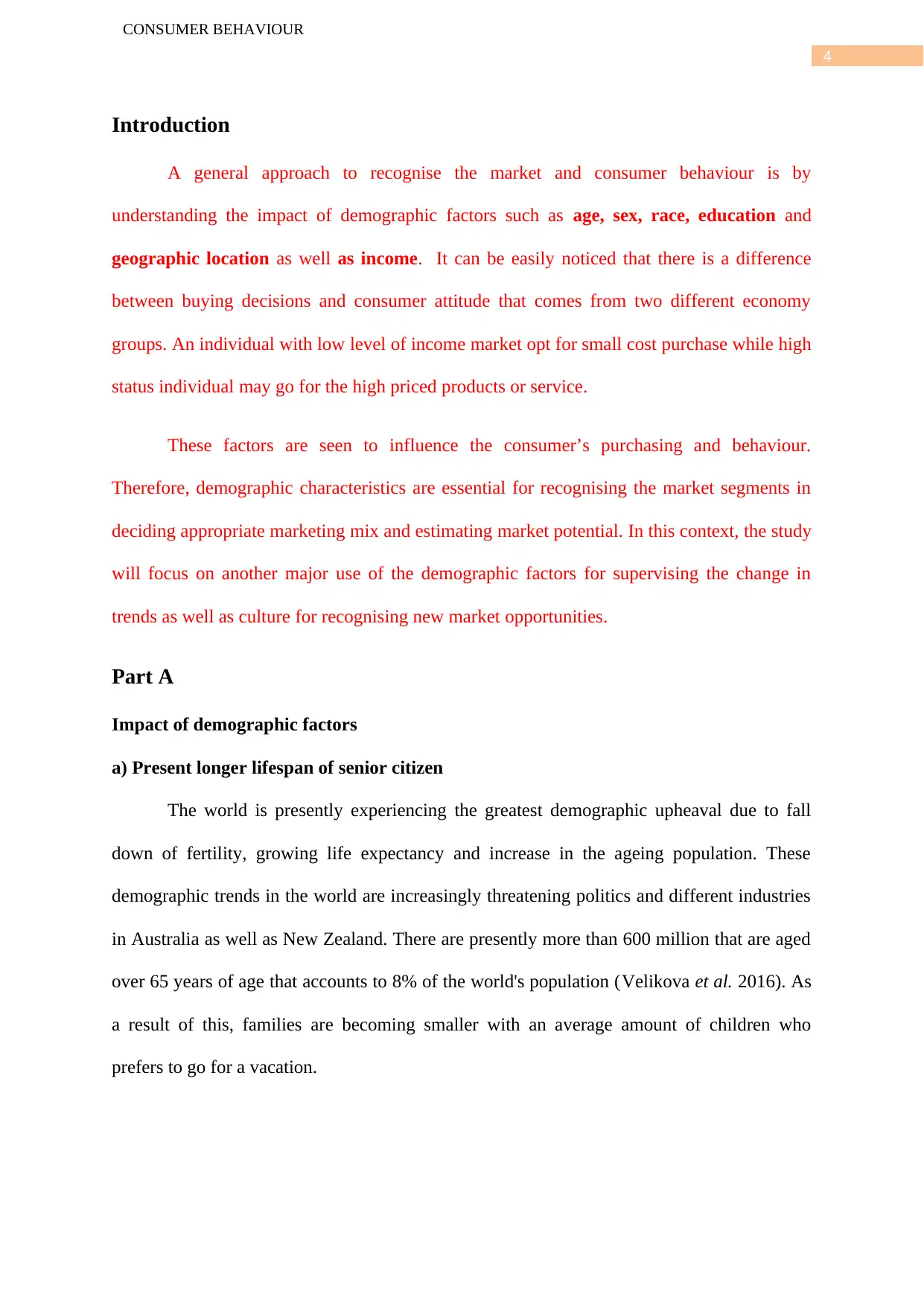
4
CONSUMER BEHAVIOUR
Introduction
A general approach to recognise the market and consumer behaviour is by
understanding the impact of demographic factors such as age, sex, race, education and
geographic location as well as income. It can be easily noticed that there is a difference
between buying decisions and consumer attitude that comes from two different economy
groups. An individual with low level of income market opt for small cost purchase while high
status individual may go for the high priced products or service.
These factors are seen to influence the consumer’s purchasing and behaviour.
Therefore, demographic characteristics are essential for recognising the market segments in
deciding appropriate marketing mix and estimating market potential. In this context, the study
will focus on another major use of the demographic factors for supervising the change in
trends as well as culture for recognising new market opportunities.
Part A
Impact of demographic factors
a) Present longer lifespan of senior citizen
The world is presently experiencing the greatest demographic upheaval due to fall
down of fertility, growing life expectancy and increase in the ageing population. These
demographic trends in the world are increasingly threatening politics and different industries
in Australia as well as New Zealand. There are presently more than 600 million that are aged
over 65 years of age that accounts to 8% of the world's population (Velikova et al. 2016). As
a result of this, families are becoming smaller with an average amount of children who
prefers to go for a vacation.
CONSUMER BEHAVIOUR
Introduction
A general approach to recognise the market and consumer behaviour is by
understanding the impact of demographic factors such as age, sex, race, education and
geographic location as well as income. It can be easily noticed that there is a difference
between buying decisions and consumer attitude that comes from two different economy
groups. An individual with low level of income market opt for small cost purchase while high
status individual may go for the high priced products or service.
These factors are seen to influence the consumer’s purchasing and behaviour.
Therefore, demographic characteristics are essential for recognising the market segments in
deciding appropriate marketing mix and estimating market potential. In this context, the study
will focus on another major use of the demographic factors for supervising the change in
trends as well as culture for recognising new market opportunities.
Part A
Impact of demographic factors
a) Present longer lifespan of senior citizen
The world is presently experiencing the greatest demographic upheaval due to fall
down of fertility, growing life expectancy and increase in the ageing population. These
demographic trends in the world are increasingly threatening politics and different industries
in Australia as well as New Zealand. There are presently more than 600 million that are aged
over 65 years of age that accounts to 8% of the world's population (Velikova et al. 2016). As
a result of this, families are becoming smaller with an average amount of children who
prefers to go for a vacation.
Paraphrase This Document
Need a fresh take? Get an instant paraphrase of this document with our AI Paraphraser
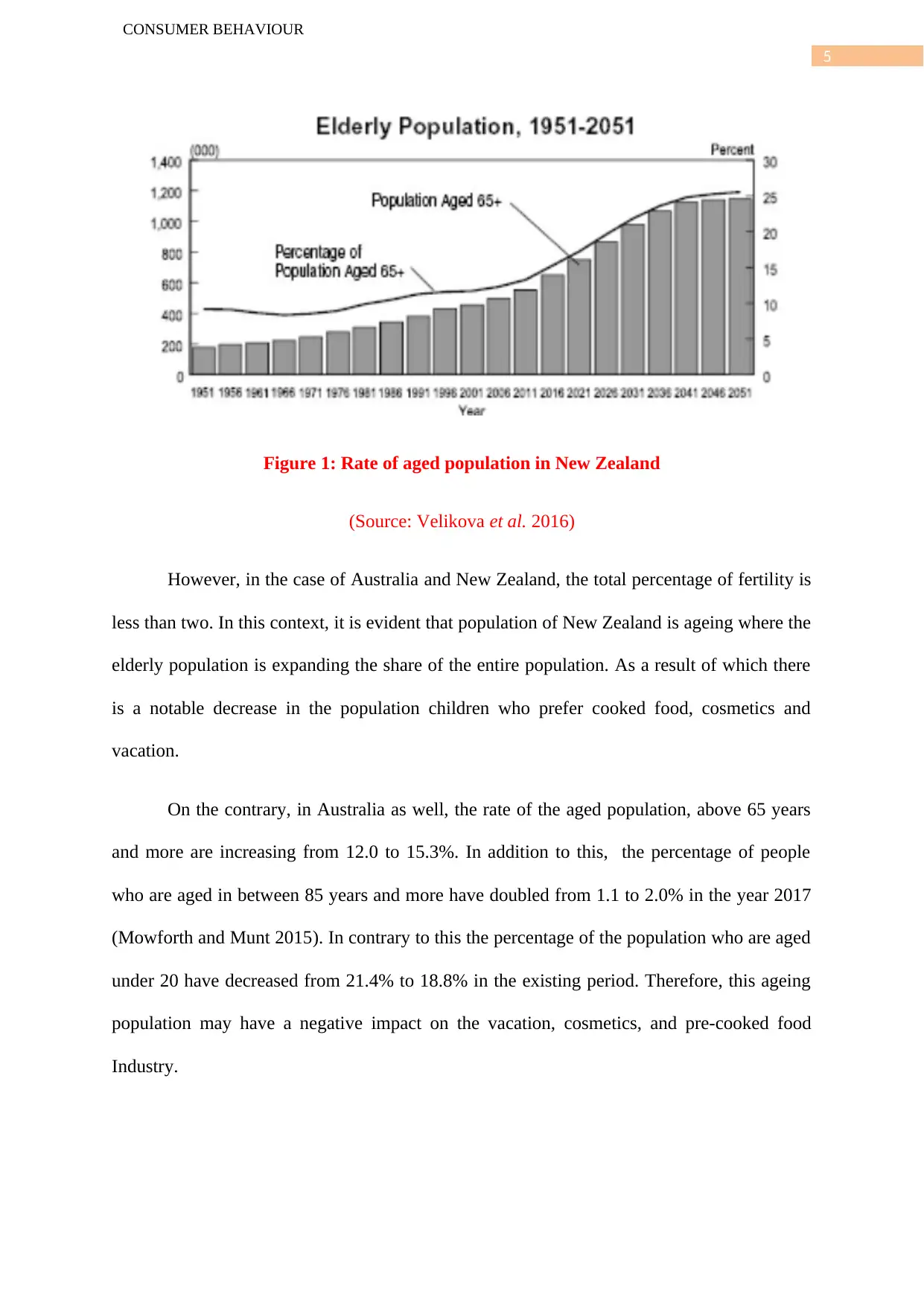
5
CONSUMER BEHAVIOUR
Figure 1: Rate of aged population in New Zealand
(Source: Velikova et al. 2016)
However, in the case of Australia and New Zealand, the total percentage of fertility is
less than two. In this context, it is evident that population of New Zealand is ageing where the
elderly population is expanding the share of the entire population. As a result of which there
is a notable decrease in the population children who prefer cooked food, cosmetics and
vacation.
On the contrary, in Australia as well, the rate of the aged population, above 65 years
and more are increasing from 12.0 to 15.3%. In addition to this, the percentage of people
who are aged in between 85 years and more have doubled from 1.1 to 2.0% in the year 2017
(Mowforth and Munt 2015). In contrary to this the percentage of the population who are aged
under 20 have decreased from 21.4% to 18.8% in the existing period. Therefore, this ageing
population may have a negative impact on the vacation, cosmetics, and pre-cooked food
Industry.
CONSUMER BEHAVIOUR
Figure 1: Rate of aged population in New Zealand
(Source: Velikova et al. 2016)
However, in the case of Australia and New Zealand, the total percentage of fertility is
less than two. In this context, it is evident that population of New Zealand is ageing where the
elderly population is expanding the share of the entire population. As a result of which there
is a notable decrease in the population children who prefer cooked food, cosmetics and
vacation.
On the contrary, in Australia as well, the rate of the aged population, above 65 years
and more are increasing from 12.0 to 15.3%. In addition to this, the percentage of people
who are aged in between 85 years and more have doubled from 1.1 to 2.0% in the year 2017
(Mowforth and Munt 2015). In contrary to this the percentage of the population who are aged
under 20 have decreased from 21.4% to 18.8% in the existing period. Therefore, this ageing
population may have a negative impact on the vacation, cosmetics, and pre-cooked food
Industry.
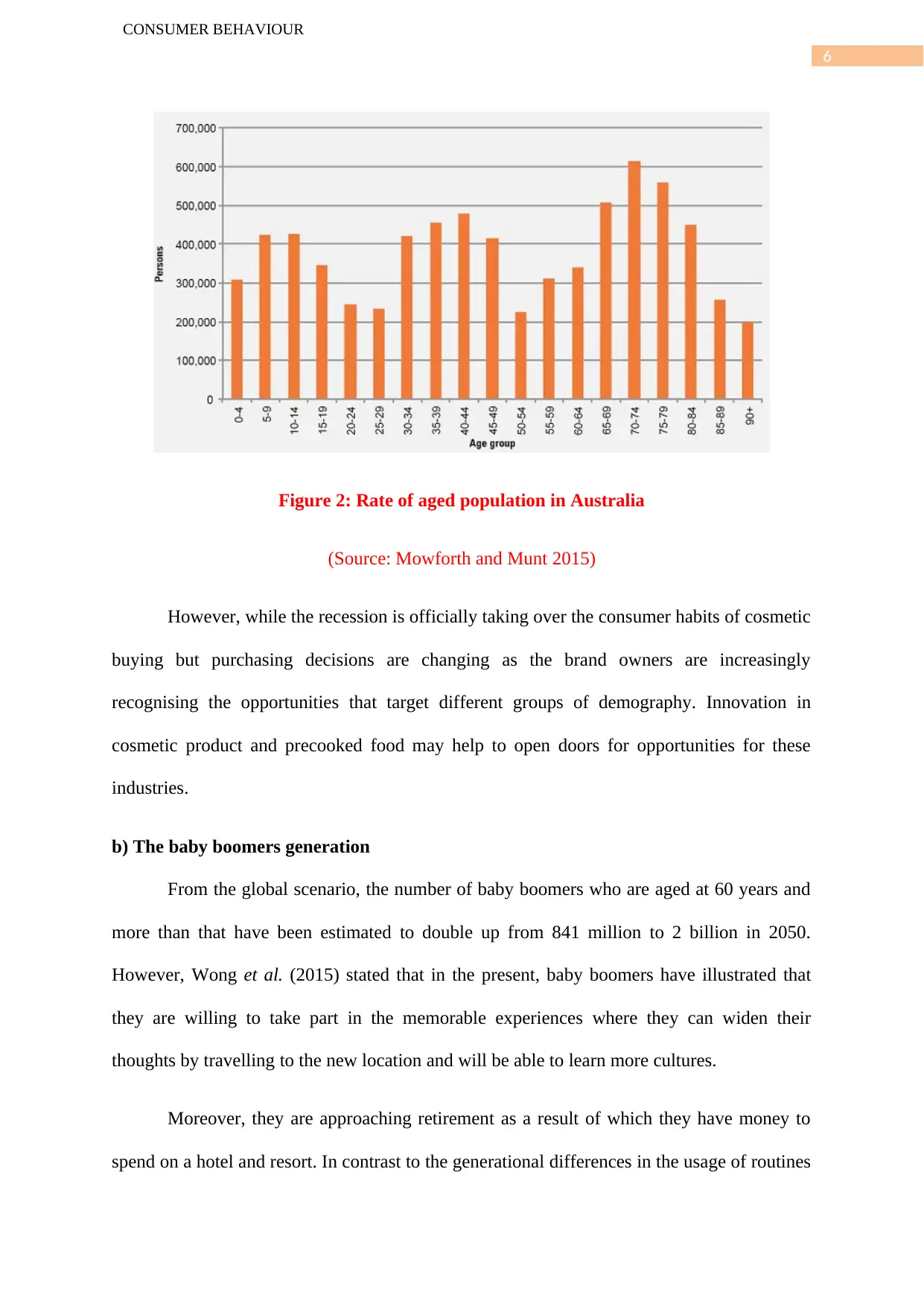
6
CONSUMER BEHAVIOUR
Figure 2: Rate of aged population in Australia
(Source: Mowforth and Munt 2015)
However, while the recession is officially taking over the consumer habits of cosmetic
buying but purchasing decisions are changing as the brand owners are increasingly
recognising the opportunities that target different groups of demography. Innovation in
cosmetic product and precooked food may help to open doors for opportunities for these
industries.
b) The baby boomers generation
From the global scenario, the number of baby boomers who are aged at 60 years and
more than that have been estimated to double up from 841 million to 2 billion in 2050.
However, Wong et al. (2015) stated that in the present, baby boomers have illustrated that
they are willing to take part in the memorable experiences where they can widen their
thoughts by travelling to the new location and will be able to learn more cultures.
Moreover, they are approaching retirement as a result of which they have money to
spend on a hotel and resort. In contrast to the generational differences in the usage of routines
CONSUMER BEHAVIOUR
Figure 2: Rate of aged population in Australia
(Source: Mowforth and Munt 2015)
However, while the recession is officially taking over the consumer habits of cosmetic
buying but purchasing decisions are changing as the brand owners are increasingly
recognising the opportunities that target different groups of demography. Innovation in
cosmetic product and precooked food may help to open doors for opportunities for these
industries.
b) The baby boomers generation
From the global scenario, the number of baby boomers who are aged at 60 years and
more than that have been estimated to double up from 841 million to 2 billion in 2050.
However, Wong et al. (2015) stated that in the present, baby boomers have illustrated that
they are willing to take part in the memorable experiences where they can widen their
thoughts by travelling to the new location and will be able to learn more cultures.
Moreover, they are approaching retirement as a result of which they have money to
spend on a hotel and resort. In contrast to the generational differences in the usage of routines
⊘ This is a preview!⊘
Do you want full access?
Subscribe today to unlock all pages.

Trusted by 1+ million students worldwide
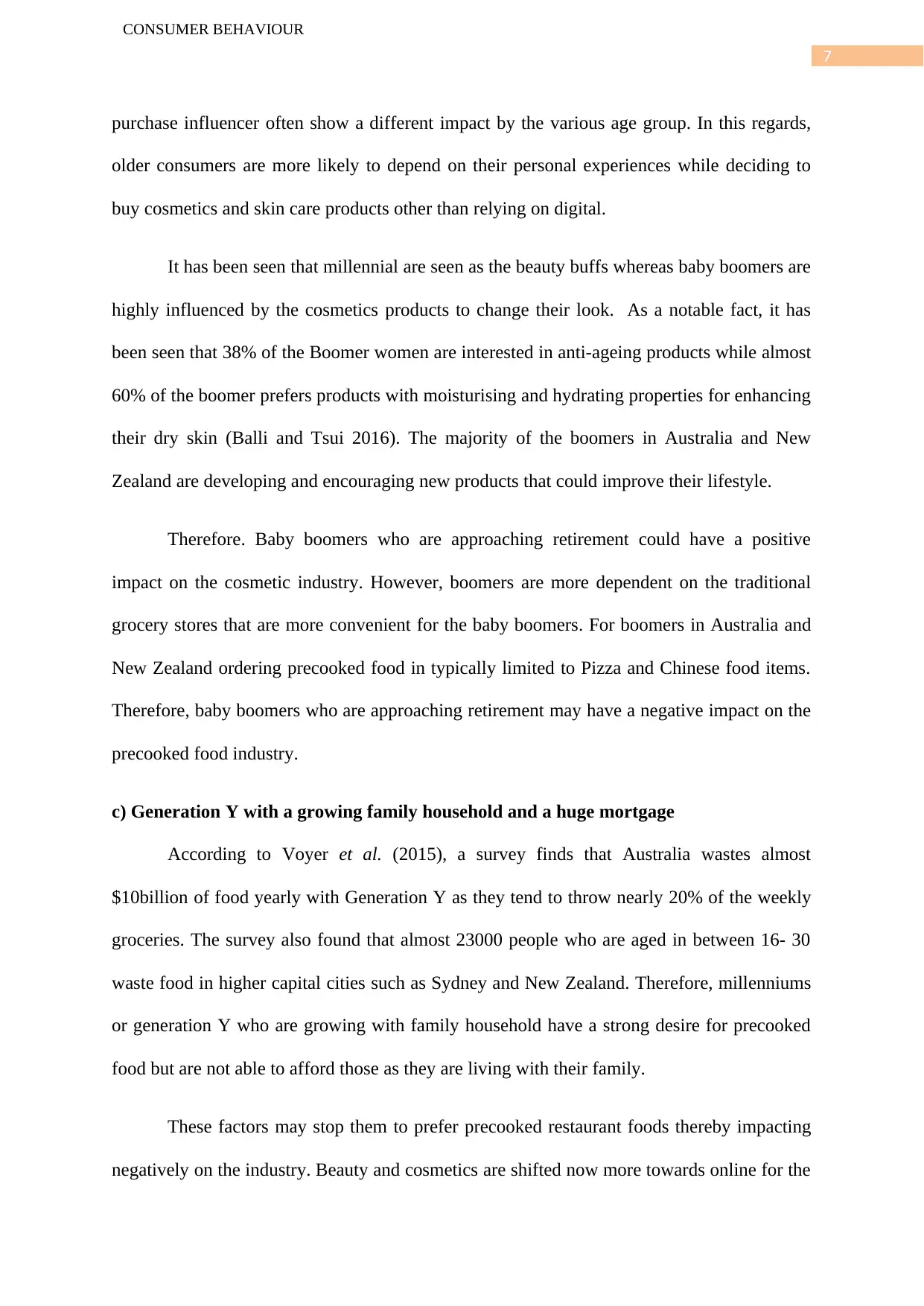
7
CONSUMER BEHAVIOUR
purchase influencer often show a different impact by the various age group. In this regards,
older consumers are more likely to depend on their personal experiences while deciding to
buy cosmetics and skin care products other than relying on digital.
It has been seen that millennial are seen as the beauty buffs whereas baby boomers are
highly influenced by the cosmetics products to change their look. As a notable fact, it has
been seen that 38% of the Boomer women are interested in anti-ageing products while almost
60% of the boomer prefers products with moisturising and hydrating properties for enhancing
their dry skin (Balli and Tsui 2016). The majority of the boomers in Australia and New
Zealand are developing and encouraging new products that could improve their lifestyle.
Therefore. Baby boomers who are approaching retirement could have a positive
impact on the cosmetic industry. However, boomers are more dependent on the traditional
grocery stores that are more convenient for the baby boomers. For boomers in Australia and
New Zealand ordering precooked food in typically limited to Pizza and Chinese food items.
Therefore, baby boomers who are approaching retirement may have a negative impact on the
precooked food industry.
c) Generation Y with a growing family household and a huge mortgage
According to Voyer et al. (2015), a survey finds that Australia wastes almost
$10billion of food yearly with Generation Y as they tend to throw nearly 20% of the weekly
groceries. The survey also found that almost 23000 people who are aged in between 16- 30
waste food in higher capital cities such as Sydney and New Zealand. Therefore, millenniums
or generation Y who are growing with family household have a strong desire for precooked
food but are not able to afford those as they are living with their family.
These factors may stop them to prefer precooked restaurant foods thereby impacting
negatively on the industry. Beauty and cosmetics are shifted now more towards online for the
CONSUMER BEHAVIOUR
purchase influencer often show a different impact by the various age group. In this regards,
older consumers are more likely to depend on their personal experiences while deciding to
buy cosmetics and skin care products other than relying on digital.
It has been seen that millennial are seen as the beauty buffs whereas baby boomers are
highly influenced by the cosmetics products to change their look. As a notable fact, it has
been seen that 38% of the Boomer women are interested in anti-ageing products while almost
60% of the boomer prefers products with moisturising and hydrating properties for enhancing
their dry skin (Balli and Tsui 2016). The majority of the boomers in Australia and New
Zealand are developing and encouraging new products that could improve their lifestyle.
Therefore. Baby boomers who are approaching retirement could have a positive
impact on the cosmetic industry. However, boomers are more dependent on the traditional
grocery stores that are more convenient for the baby boomers. For boomers in Australia and
New Zealand ordering precooked food in typically limited to Pizza and Chinese food items.
Therefore, baby boomers who are approaching retirement may have a negative impact on the
precooked food industry.
c) Generation Y with a growing family household and a huge mortgage
According to Voyer et al. (2015), a survey finds that Australia wastes almost
$10billion of food yearly with Generation Y as they tend to throw nearly 20% of the weekly
groceries. The survey also found that almost 23000 people who are aged in between 16- 30
waste food in higher capital cities such as Sydney and New Zealand. Therefore, millenniums
or generation Y who are growing with family household have a strong desire for precooked
food but are not able to afford those as they are living with their family.
These factors may stop them to prefer precooked restaurant foods thereby impacting
negatively on the industry. Beauty and cosmetics are shifted now more towards online for the
Paraphrase This Document
Need a fresh take? Get an instant paraphrase of this document with our AI Paraphraser
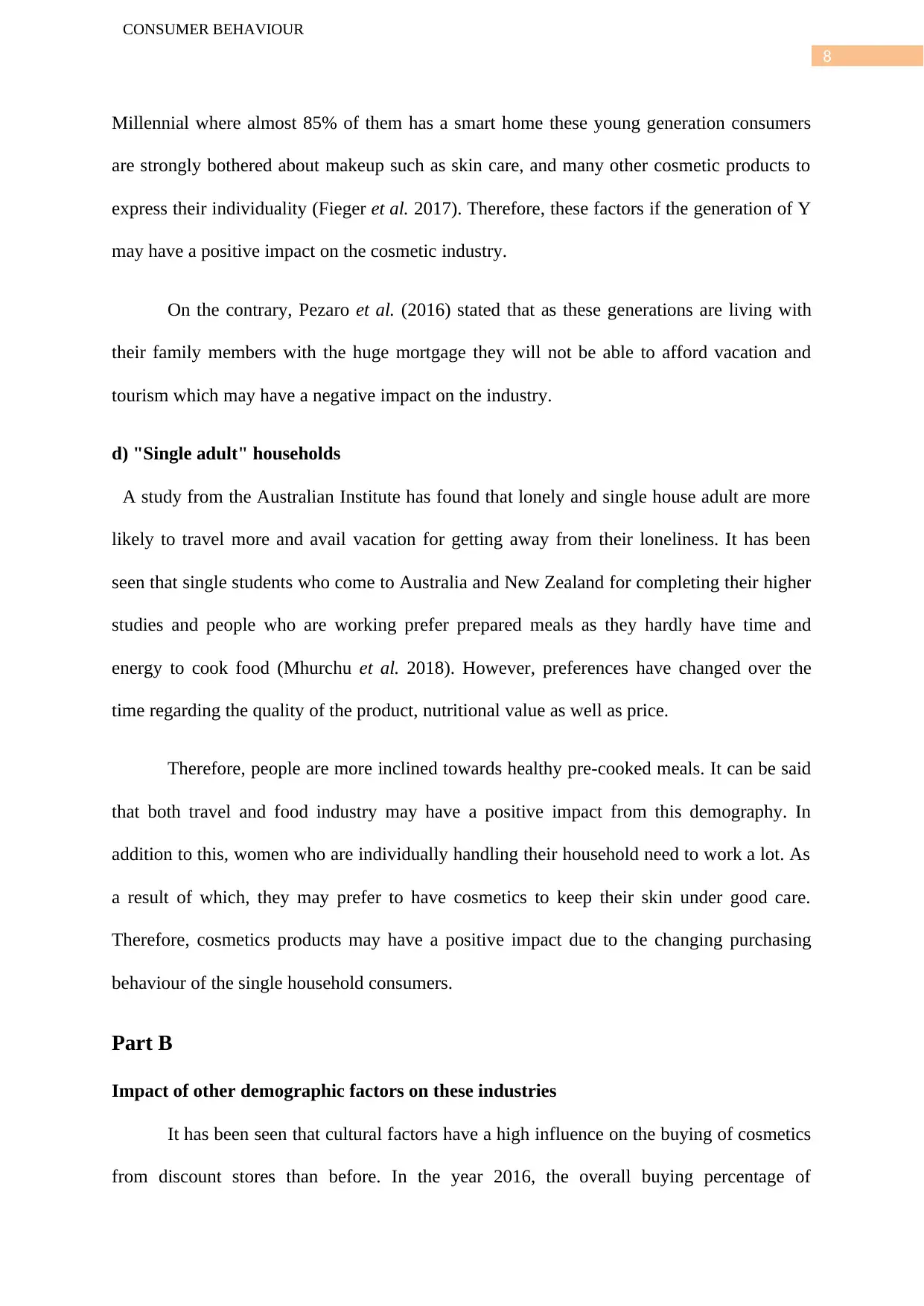
8
CONSUMER BEHAVIOUR
Millennial where almost 85% of them has a smart home these young generation consumers
are strongly bothered about makeup such as skin care, and many other cosmetic products to
express their individuality (Fieger et al. 2017). Therefore, these factors if the generation of Y
may have a positive impact on the cosmetic industry.
On the contrary, Pezaro et al. (2016) stated that as these generations are living with
their family members with the huge mortgage they will not be able to afford vacation and
tourism which may have a negative impact on the industry.
d) "Single adult" households
A study from the Australian Institute has found that lonely and single house adult are more
likely to travel more and avail vacation for getting away from their loneliness. It has been
seen that single students who come to Australia and New Zealand for completing their higher
studies and people who are working prefer prepared meals as they hardly have time and
energy to cook food (Mhurchu et al. 2018). However, preferences have changed over the
time regarding the quality of the product, nutritional value as well as price.
Therefore, people are more inclined towards healthy pre-cooked meals. It can be said
that both travel and food industry may have a positive impact from this demography. In
addition to this, women who are individually handling their household need to work a lot. As
a result of which, they may prefer to have cosmetics to keep their skin under good care.
Therefore, cosmetics products may have a positive impact due to the changing purchasing
behaviour of the single household consumers.
Part B
Impact of other demographic factors on these industries
It has been seen that cultural factors have a high influence on the buying of cosmetics
from discount stores than before. In the year 2016, the overall buying percentage of
CONSUMER BEHAVIOUR
Millennial where almost 85% of them has a smart home these young generation consumers
are strongly bothered about makeup such as skin care, and many other cosmetic products to
express their individuality (Fieger et al. 2017). Therefore, these factors if the generation of Y
may have a positive impact on the cosmetic industry.
On the contrary, Pezaro et al. (2016) stated that as these generations are living with
their family members with the huge mortgage they will not be able to afford vacation and
tourism which may have a negative impact on the industry.
d) "Single adult" households
A study from the Australian Institute has found that lonely and single house adult are more
likely to travel more and avail vacation for getting away from their loneliness. It has been
seen that single students who come to Australia and New Zealand for completing their higher
studies and people who are working prefer prepared meals as they hardly have time and
energy to cook food (Mhurchu et al. 2018). However, preferences have changed over the
time regarding the quality of the product, nutritional value as well as price.
Therefore, people are more inclined towards healthy pre-cooked meals. It can be said
that both travel and food industry may have a positive impact from this demography. In
addition to this, women who are individually handling their household need to work a lot. As
a result of which, they may prefer to have cosmetics to keep their skin under good care.
Therefore, cosmetics products may have a positive impact due to the changing purchasing
behaviour of the single household consumers.
Part B
Impact of other demographic factors on these industries
It has been seen that cultural factors have a high influence on the buying of cosmetics
from discount stores than before. In the year 2016, the overall buying percentage of
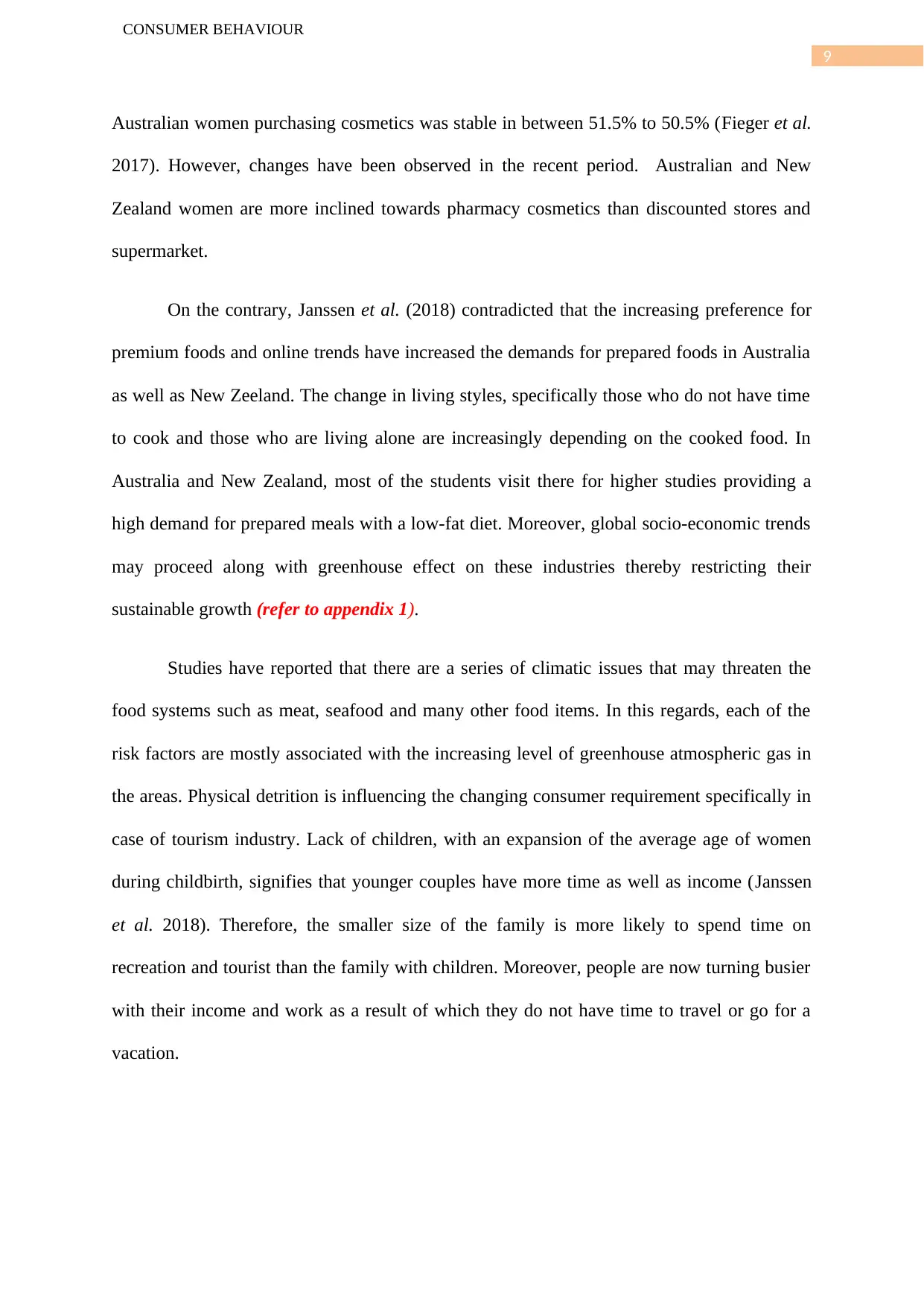
9
CONSUMER BEHAVIOUR
Australian women purchasing cosmetics was stable in between 51.5% to 50.5% (Fieger et al.
2017). However, changes have been observed in the recent period. Australian and New
Zealand women are more inclined towards pharmacy cosmetics than discounted stores and
supermarket.
On the contrary, Janssen et al. (2018) contradicted that the increasing preference for
premium foods and online trends have increased the demands for prepared foods in Australia
as well as New Zeeland. The change in living styles, specifically those who do not have time
to cook and those who are living alone are increasingly depending on the cooked food. In
Australia and New Zealand, most of the students visit there for higher studies providing a
high demand for prepared meals with a low-fat diet. Moreover, global socio-economic trends
may proceed along with greenhouse effect on these industries thereby restricting their
sustainable growth (refer to appendix 1).
Studies have reported that there are a series of climatic issues that may threaten the
food systems such as meat, seafood and many other food items. In this regards, each of the
risk factors are mostly associated with the increasing level of greenhouse atmospheric gas in
the areas. Physical detrition is influencing the changing consumer requirement specifically in
case of tourism industry. Lack of children, with an expansion of the average age of women
during childbirth, signifies that younger couples have more time as well as income (Janssen
et al. 2018). Therefore, the smaller size of the family is more likely to spend time on
recreation and tourist than the family with children. Moreover, people are now turning busier
with their income and work as a result of which they do not have time to travel or go for a
vacation.
CONSUMER BEHAVIOUR
Australian women purchasing cosmetics was stable in between 51.5% to 50.5% (Fieger et al.
2017). However, changes have been observed in the recent period. Australian and New
Zealand women are more inclined towards pharmacy cosmetics than discounted stores and
supermarket.
On the contrary, Janssen et al. (2018) contradicted that the increasing preference for
premium foods and online trends have increased the demands for prepared foods in Australia
as well as New Zeeland. The change in living styles, specifically those who do not have time
to cook and those who are living alone are increasingly depending on the cooked food. In
Australia and New Zealand, most of the students visit there for higher studies providing a
high demand for prepared meals with a low-fat diet. Moreover, global socio-economic trends
may proceed along with greenhouse effect on these industries thereby restricting their
sustainable growth (refer to appendix 1).
Studies have reported that there are a series of climatic issues that may threaten the
food systems such as meat, seafood and many other food items. In this regards, each of the
risk factors are mostly associated with the increasing level of greenhouse atmospheric gas in
the areas. Physical detrition is influencing the changing consumer requirement specifically in
case of tourism industry. Lack of children, with an expansion of the average age of women
during childbirth, signifies that younger couples have more time as well as income (Janssen
et al. 2018). Therefore, the smaller size of the family is more likely to spend time on
recreation and tourist than the family with children. Moreover, people are now turning busier
with their income and work as a result of which they do not have time to travel or go for a
vacation.
⊘ This is a preview!⊘
Do you want full access?
Subscribe today to unlock all pages.

Trusted by 1+ million students worldwide
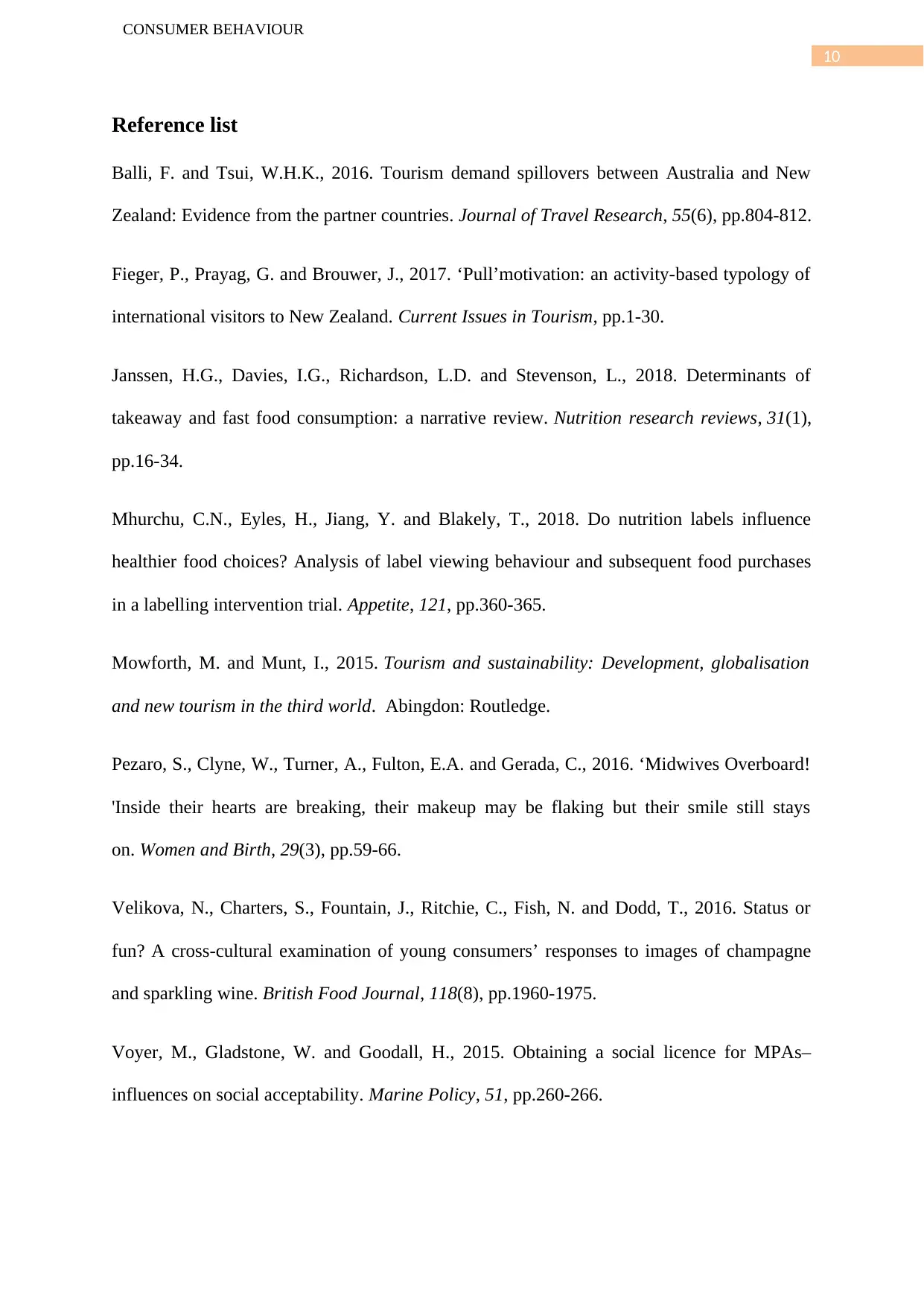
10
CONSUMER BEHAVIOUR
Reference list
Balli, F. and Tsui, W.H.K., 2016. Tourism demand spillovers between Australia and New
Zealand: Evidence from the partner countries. Journal of Travel Research, 55(6), pp.804-812.
Fieger, P., Prayag, G. and Brouwer, J., 2017. ‘Pull’motivation: an activity-based typology of
international visitors to New Zealand. Current Issues in Tourism, pp.1-30.
Janssen, H.G., Davies, I.G., Richardson, L.D. and Stevenson, L., 2018. Determinants of
takeaway and fast food consumption: a narrative review. Nutrition research reviews, 31(1),
pp.16-34.
Mhurchu, C.N., Eyles, H., Jiang, Y. and Blakely, T., 2018. Do nutrition labels influence
healthier food choices? Analysis of label viewing behaviour and subsequent food purchases
in a labelling intervention trial. Appetite, 121, pp.360-365.
Mowforth, M. and Munt, I., 2015. Tourism and sustainability: Development, globalisation
and new tourism in the third world. Abingdon: Routledge.
Pezaro, S., Clyne, W., Turner, A., Fulton, E.A. and Gerada, C., 2016. ‘Midwives Overboard!
'Inside their hearts are breaking, their makeup may be flaking but their smile still stays
on. Women and Birth, 29(3), pp.59-66.
Velikova, N., Charters, S., Fountain, J., Ritchie, C., Fish, N. and Dodd, T., 2016. Status or
fun? A cross-cultural examination of young consumers’ responses to images of champagne
and sparkling wine. British Food Journal, 118(8), pp.1960-1975.
Voyer, M., Gladstone, W. and Goodall, H., 2015. Obtaining a social licence for MPAs–
influences on social acceptability. Marine Policy, 51, pp.260-266.
CONSUMER BEHAVIOUR
Reference list
Balli, F. and Tsui, W.H.K., 2016. Tourism demand spillovers between Australia and New
Zealand: Evidence from the partner countries. Journal of Travel Research, 55(6), pp.804-812.
Fieger, P., Prayag, G. and Brouwer, J., 2017. ‘Pull’motivation: an activity-based typology of
international visitors to New Zealand. Current Issues in Tourism, pp.1-30.
Janssen, H.G., Davies, I.G., Richardson, L.D. and Stevenson, L., 2018. Determinants of
takeaway and fast food consumption: a narrative review. Nutrition research reviews, 31(1),
pp.16-34.
Mhurchu, C.N., Eyles, H., Jiang, Y. and Blakely, T., 2018. Do nutrition labels influence
healthier food choices? Analysis of label viewing behaviour and subsequent food purchases
in a labelling intervention trial. Appetite, 121, pp.360-365.
Mowforth, M. and Munt, I., 2015. Tourism and sustainability: Development, globalisation
and new tourism in the third world. Abingdon: Routledge.
Pezaro, S., Clyne, W., Turner, A., Fulton, E.A. and Gerada, C., 2016. ‘Midwives Overboard!
'Inside their hearts are breaking, their makeup may be flaking but their smile still stays
on. Women and Birth, 29(3), pp.59-66.
Velikova, N., Charters, S., Fountain, J., Ritchie, C., Fish, N. and Dodd, T., 2016. Status or
fun? A cross-cultural examination of young consumers’ responses to images of champagne
and sparkling wine. British Food Journal, 118(8), pp.1960-1975.
Voyer, M., Gladstone, W. and Goodall, H., 2015. Obtaining a social licence for MPAs–
influences on social acceptability. Marine Policy, 51, pp.260-266.
Paraphrase This Document
Need a fresh take? Get an instant paraphrase of this document with our AI Paraphraser
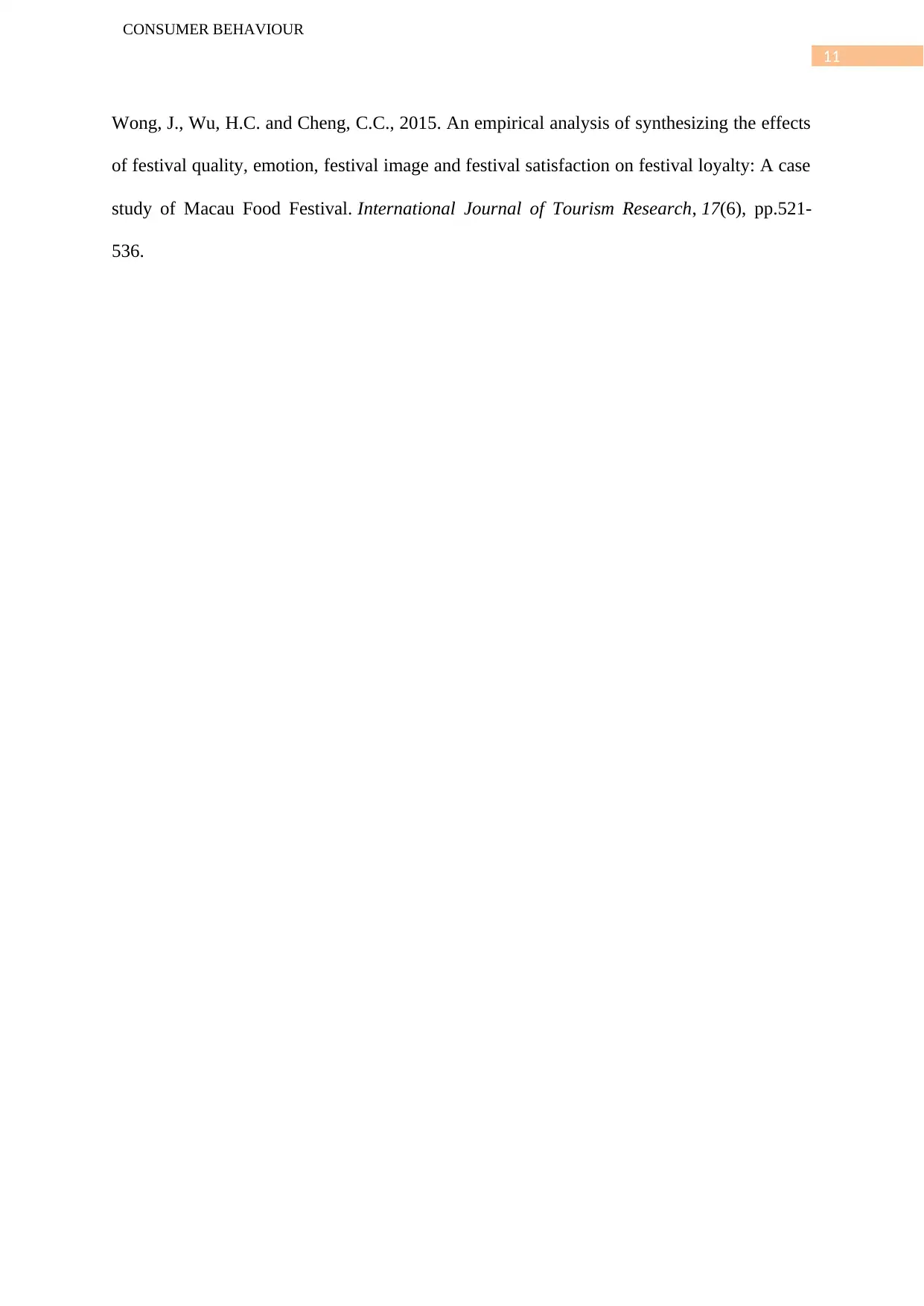
11
CONSUMER BEHAVIOUR
Wong, J., Wu, H.C. and Cheng, C.C., 2015. An empirical analysis of synthesizing the effects
of festival quality, emotion, festival image and festival satisfaction on festival loyalty: A case
study of Macau Food Festival. International Journal of Tourism Research, 17(6), pp.521-
536.
CONSUMER BEHAVIOUR
Wong, J., Wu, H.C. and Cheng, C.C., 2015. An empirical analysis of synthesizing the effects
of festival quality, emotion, festival image and festival satisfaction on festival loyalty: A case
study of Macau Food Festival. International Journal of Tourism Research, 17(6), pp.521-
536.
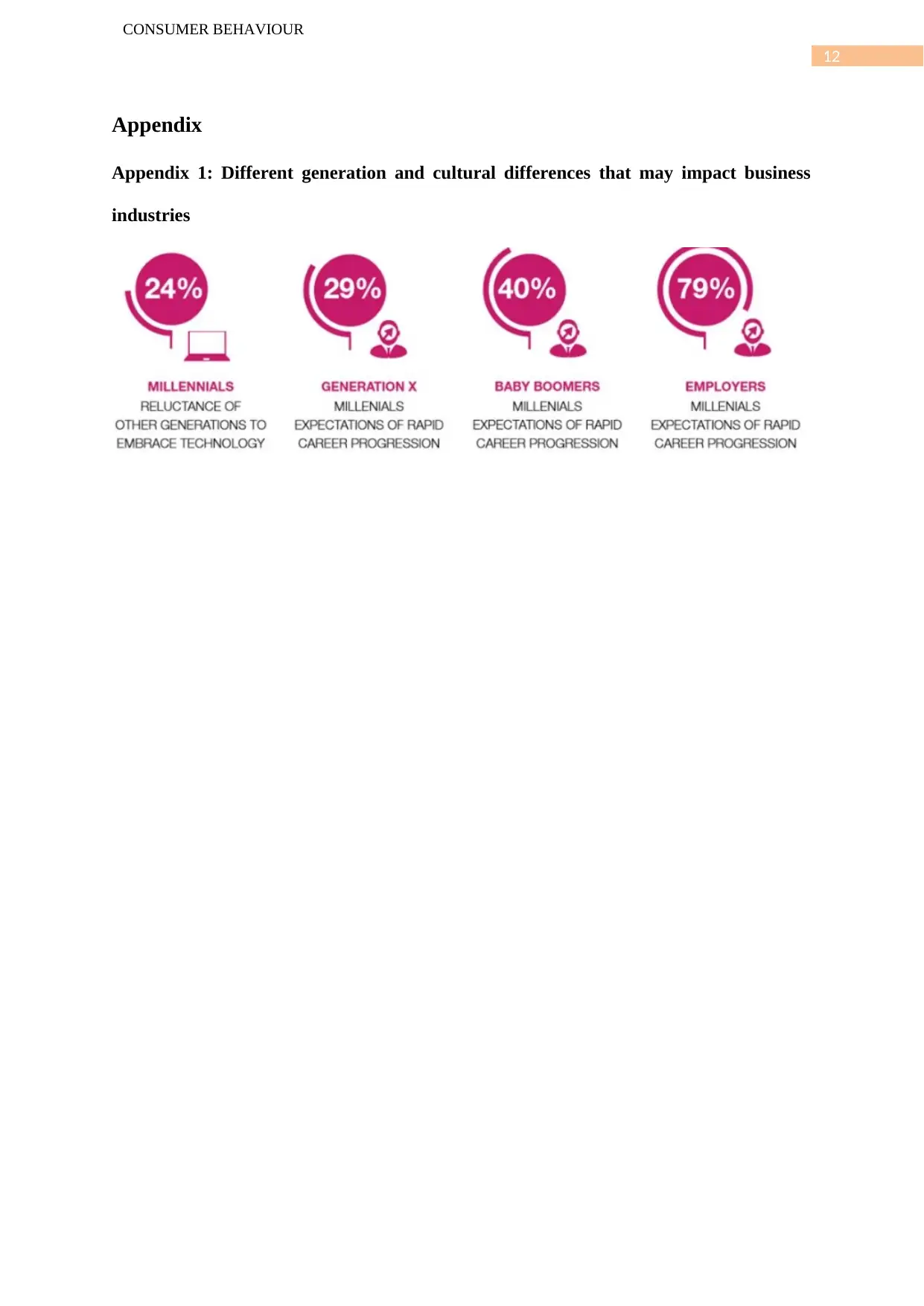
12
CONSUMER BEHAVIOUR
Appendix
Appendix 1: Different generation and cultural differences that may impact business
industries
CONSUMER BEHAVIOUR
Appendix
Appendix 1: Different generation and cultural differences that may impact business
industries
⊘ This is a preview!⊘
Do you want full access?
Subscribe today to unlock all pages.

Trusted by 1+ million students worldwide
1 out of 12
Related Documents
Your All-in-One AI-Powered Toolkit for Academic Success.
+13062052269
info@desklib.com
Available 24*7 on WhatsApp / Email
![[object Object]](/_next/static/media/star-bottom.7253800d.svg)
Unlock your academic potential
Copyright © 2020–2025 A2Z Services. All Rights Reserved. Developed and managed by ZUCOL.





